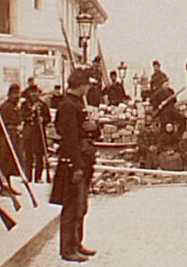|
_________________________________________________________________
Contents (A) Protagonists of the Marginalist Revolution Back The Marginalist Revolution refers to the establishment of what has been since called Neoclassical approach to economic theory. The dating of this "revolution" is commonly ascribed to 1871-74, when the concept of diminishing marginal utility was introduced by William Stanley Jevons, Carl Menger and Léon Walras, to pin down the character of demand -- thus the term "Marginalist". This set the foundations for the Neoclassical theory of value, which eventually replaced the "Classical" theory of value of Adam Smith, David Ricardo, John Stuart Mill and Karl Marx. However, the task of establishing the Neoclassical theory as the dominant approach to economics took quite some time. It can be roughly seen as a three-phase affair:
Thus, we can think of the 1871-74 period merely as the "Marginalist Insurrection", the "Revolution" itself taking a further half-century or so to work itself out fully. To obtain a quick glance of the story, a timeline denoting the main contributions of the protagonists of the Marginalist Revolution follows: Main Proto-Marginalists
The Revolutionaries
The Consolidators
The Revivalists
This account is not beyond dispute, but we have tried to adhere rigidly to the main contributions to the canonical Neoclassical theory of value. Thus, we have insisted on Böhm-Bawerk's 1886 article on value rather than his more famous theory of capital as the latter did not enter into the mainstream. The conspicuous omission of Francis Ysidro Edgeworth (English, b.1845) from this list, in spite of the importance and originality of his contributions, notably his 1881 Mathematical Psychics, is excused by the fact that his work is really too specialized and digresses too far from the standard Neoclassical canon to permit us to call him a "consolidator" of the Marginalist Revolution. Another notable absentee, Gusav Cassel (Swedish, b.1866), is excluded despite the importance of his 1918 Theory of Social Economy in the revival of Neoclassical theory because he decided to dispense with utility theory entirely. Naturally, there are many other contributors whose work deserves mention but, in our view, these were the most important, original and influential contributions to the Neoclassical theory of value. (B) Basic Elements of the Neoclassical Theory of Value Despite the name, the essence of the Marginalist Revolution was not really the mathematical concept of the "margin", but rather in the building up of a theory of value which was based on the phenomenon of exchange rather than production and distribution. William F. Lloyd's definition of economics as catallactics - the "science of exchange" - better describes what the Marginalists were aiming for -- and what Neoclassicism, at is heart, is all about. The essence of Marginalist Revolution, then, was the novel idea that the "natural value" of a good is determined only by its subjective scarcity, i.e. the degree to which people's desire for that good exceeds its availability. The Neoclassical story is often captured in diagrammatic form by the idea that equilibrium prices and quantities of goods are determined jointly and simultaneously by the demand and supply for those goods. The basic distinguishing principles of the Neoclassical theory of value can be listed in point form as follows:
These twelve points effectively capture the main message of the Neoclassical "Marginalist Revolution". Other items that have since be called "Neoclassical", such as the Quantity Theory of Money or Say's Law, are not distinctly Neoclassical as, firstly, they were originally developed and thus are shared with the Classical economists (Smith, Ricardo, Mill, etc.) and, secondly, not all Neoclassical economists subscribed to them (e.g. Wicksell). It has also been argued that the use of the mathematical reasoning can be considered a characteristic of the Marginalist Revolution. This is not true. Although some Marginalists (e.g. Walras, Wicksteed) employed a largely unprecedented amount of mathematics, others (e.g. Menger, Clark), were quite ignorant of it and did not use it at all. Notice also that we have omitted any description of the dynamics of Neoclassical theory. We say nothing about how the equilibrium is supposed to come about or how the system evolves over time. Once again, Neoclassical thinkers had different ideas about this. Walras, Menger and Marshall, for instance, had rather incompatible notions of how prices and quantities adjusted when out of equilibrium. Furthermore, some Neoclassicals (e.g. Marshall) argued that equilibrium itself was a gravitation point that the system would approach over time, while others (e.g. Fisher) argued that equilibrium was itself defined over time ("intertemporally") and still others (e.g. Walras) argued that equilibrium ought to be defined as a steady-state which maintains itself through time; alternatively, others (e.g. Walras again) argued that equilibrium is merely a temporary, short-run thing and that, over time, there would be a sequence of different equilibria. Thus, the dynamic aspects of the Neoclassical system were hardly agreed upon by the protagonists of the Marginalist Revolution. (C) The Neoclassical Family of Schools The "Neoclassical" approach to economics, thus, is not one, great, well-defined theory, but rather can be regarded as a family of approaches -- all of which share the core 12 points mentioned earlier, but differ considerably on other topics such as macroeconomics, money, dynamics, mathematics, etc. Neoclassicism is thus a collection of schools of thought. The following is a list of the main Neoclassical schools, and their main geographical and periods of chronological concentration. We should warn that this is not a generally-accepted account.
Naturally, there are also the few giants who had their own, distinct vision of Neoclassicism and thus are not easily classifiable within the schools listed above, but who also failed to form a clearly discernible "school of thought" behind them. These include William Stanley Jevons, Phillip H. Wicksteed, Francis Ysidro Edgeworth, Irving Fisher and John Bates Clark. These can be thought as plain "Neoclassicals", although we have taken the liberty of grouping them together under the title of "Anglo-American Marginalists"
|
All rights reserved, Gonçalo L. Fonseca

